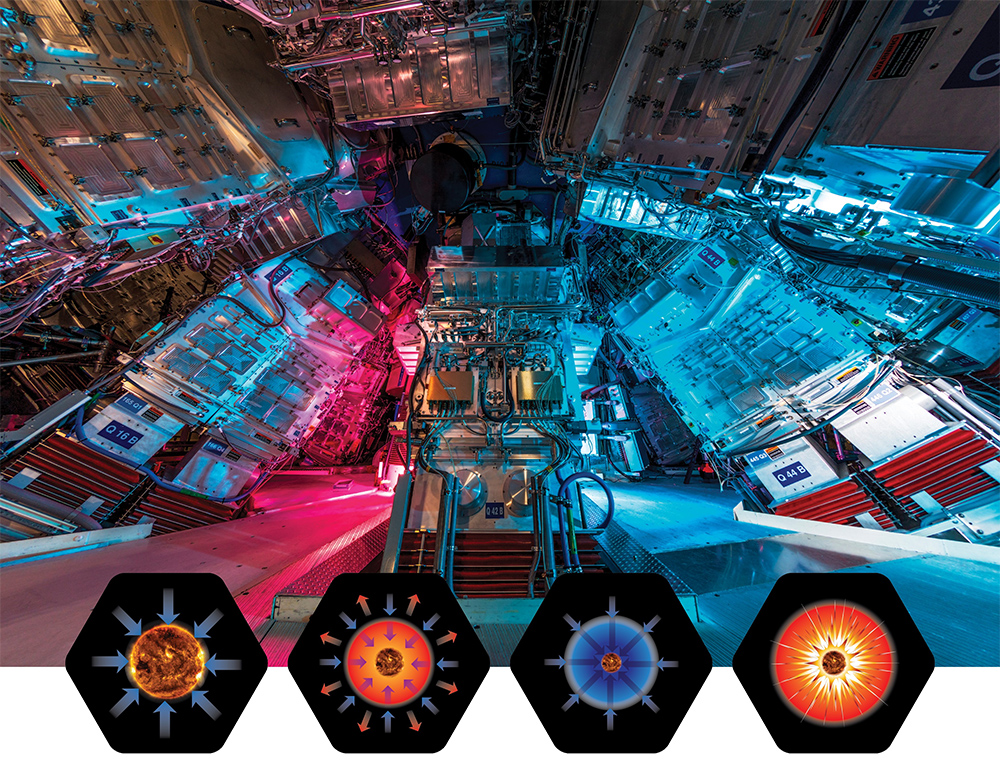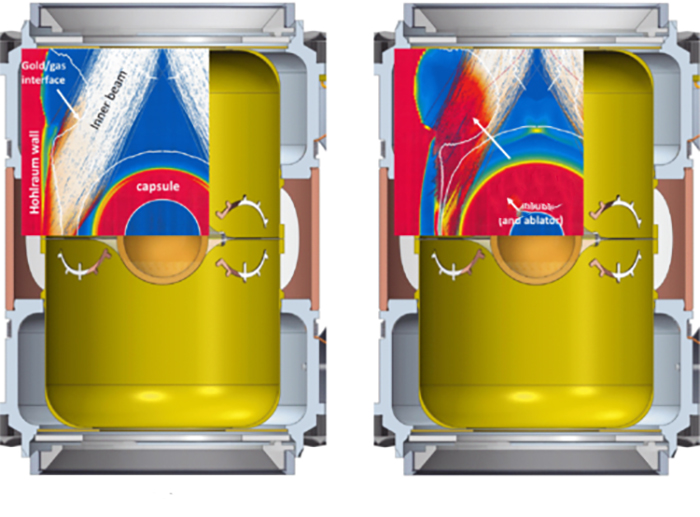Tracing the Steps to LLNL’s Fusion
Ignition Breakthrough
February 5, 2024
The years following the dedication of Lawrence Livermore National Laboratory (LLNL)’s National Ignition Facility (NIF) in 2009 were a time of head-scratching frustration for the Lab’s researchers and their colleagues in the inertial confinement fusion (ICF) community.
Many ICF researchers had been convinced that NIF, the world’s largest and highest-energy laser system, would live up to its promise of ignition within one to two years of the first ignition experiments in 2011. Ignition on NIF means the nuclear fusion reactions sparked by the lasers produce as much or more energy than the laser energy delivered to the target—the definition of ignition used by the National Academy of Science in a 1997 review of NIF (see “Achieving Fusion Ignition”).
 (Above) A view from the Target Bay of some of the final optics assemblies surrounding the NIF Target Chamber, the site of NIF’s inertial confinement fusion experiments. (Below) Illustration of the stages of an ICF implosion. Photo credit: Jason Laurea; image credit: Brian Chavez
(Above) A view from the Target Bay of some of the final optics assemblies surrounding the NIF Target Chamber, the site of NIF’s inertial confinement fusion experiments. (Below) Illustration of the stages of an ICF implosion. Photo credit: Jason Laurea; image credit: Brian Chavez But the results of the first few dozen NIF shots fell well short of the predictions derived from computer models. The experiments produced only one to two kilojoules of energy—a small fraction of the 1.8 million joules fired into the pencil-eraser-sized cylinders, called hohlraums, containing NIF’s tiny plastic target capsules (see “How NIF Targets Work”). The implosions were unstable and asymmetric and had a high level of energy-sapping laser-plasma interactions (LPI).

Over the next 10 years, as the models and the ability to interpret them improved, and the researchers benefitted from an ever-growing knowledge base provided by NIF’s sophisticated diagnostic equipment, the impediments to successful implosions—asymmetries, LPI, fuel contamination by target capsule material, radiative losses, laser backscatter and hot-electron production, and other instabilities—were gradually overcome.
The inside story of how ICF researchers solved those and other physics and engineering challenges to finally achieve target energy gain at LLNL on Dec. 5, 2022, is told in a comprehensive Reviews of Modern Physics article published last summer.
ICF Chief Scientist Omar Hurricane, the article’s lead author, credited the NIF operations, diagnostics, optics, and modeling teams and the Livermore and General Atomics target fabrication teams, as well as colleagues in the ICF and high energy density (HED) programs at Livermore and in institutions around the world, for the “incredible progress over the past decade.”
Along with describing the laser indirect-drive experiments that led to the historic fusion breakthrough on NIF, the article also covers the achievements of the two other chief approaches to ICF in the United States—laser direct drive at the OMEGA laser at the University of Rochester’s Laboratory for Laser Energetics (LLE), and magnetic drive at the Z pulsed power facility at Sandia National Laboratories (SNL).
“For many decades the running joke in fusion research has been that ‘fusion is 20 years away and always will be,’” the authors noted. “Yet, we currently find ourselves in a position where we can refer to the milestones of burning plasmas, fusion ignition, and target energy gain greater than unity (i.e., ‘scientific breakeven’) in the past tense!
“While there have been periods of frustration on the road to ICF ignition,” they said, “recent research has demonstrated great leaps in understanding what aspects of the implosions need more control. Tangible progress in ICF is evident as burning plasmas and ignited plasmas have recently been generated, repeatedly, on the NIF stemming from decades of science and engineering understanding generated from work at the three…facilities and in the international community.
Building on Success
“What remains is to build upon these recent results by increasing energy coupling to the indirect-drive targets and then understanding and correcting the limitations presently observed with respect to compression.
“Across the U.S. ICF program,” the authors concluded, “our understanding of what physics and engineering principles are key is improving at a rapid pace. There are many commonalities to the problems that indirect drive, direct drive, and magnetic drive face. The underlying physics principles of ICF are the same regardless of the approach.
“Given that we now have an existence proof of fusion ignition and scientific breakeven in the laboratory, the future of ICF looks bright.”
ICF research is a key component of the National Nuclear Administration’s science-based Stockpile Stewardship Program to insure the safety, security, and reliability of the U.S. nuclear stockpile without the need for underground testing.
Hurricane said he “jumped at the chance” when he was asked by the editors of Reviews of Modern Physics to write an article on the U.S. ICF program. He said he was inspired by a “unique series of nuclear physics articles” in Reviews of Modern Physics by the renowned theoretical physicist Hans Bethe, along with Robert Bacher and M. Stanley Livingston, in 1936-1938.
“When I was a student, I read these articles and I still have copies of them in the form of a bound book because they are such a masterwork,” Hurricane said.
The current article was written during the COVID pandemic and focuses on ICF work during the decade prior to 2022, but it also refers to recent results, such as the three additional ignition experiments on NIF in 2023, and work prior to 2010.
Hurricane thanked his co-authors—former LLNL colleague Pravesh Patel, now with Focused Energy Inc., of Austin, Texas; Riccardo Betti, Dustin Froula, and Sean Regan from LLE; and Stephen Slutz, Matthew Gomez, and Mary Ann Sweeney from SNL—for their contributions.
More Information:
“LLNL’s Breakthrough Ignition Experiment Highlighted in Physical Review Letters,” NIF & Photon Science News, February 5, 2024
“Physics principles of inertial confinement fusion and U.S. program overview,” Reviews of Modern Physics, June 27, 2023
“LLNL’s NIF Delivers Record Laser Energy,” NIF & Photon Science News, November 16, 2023
“Building to a Solution: The Elements of a Fusion Breakthrough,” NIF & Photon Science News, November 2, 2021
—Charlie Osolin
Follow us on Twitter: @lasers_llnl




